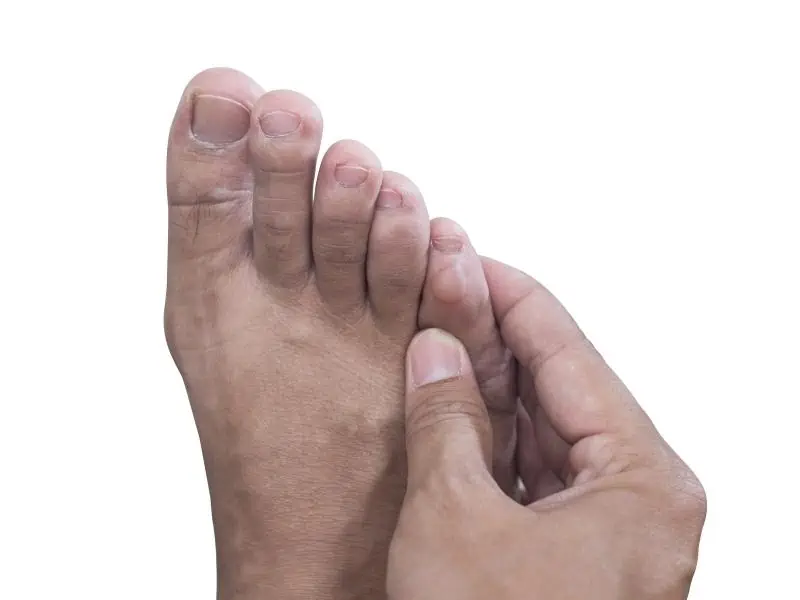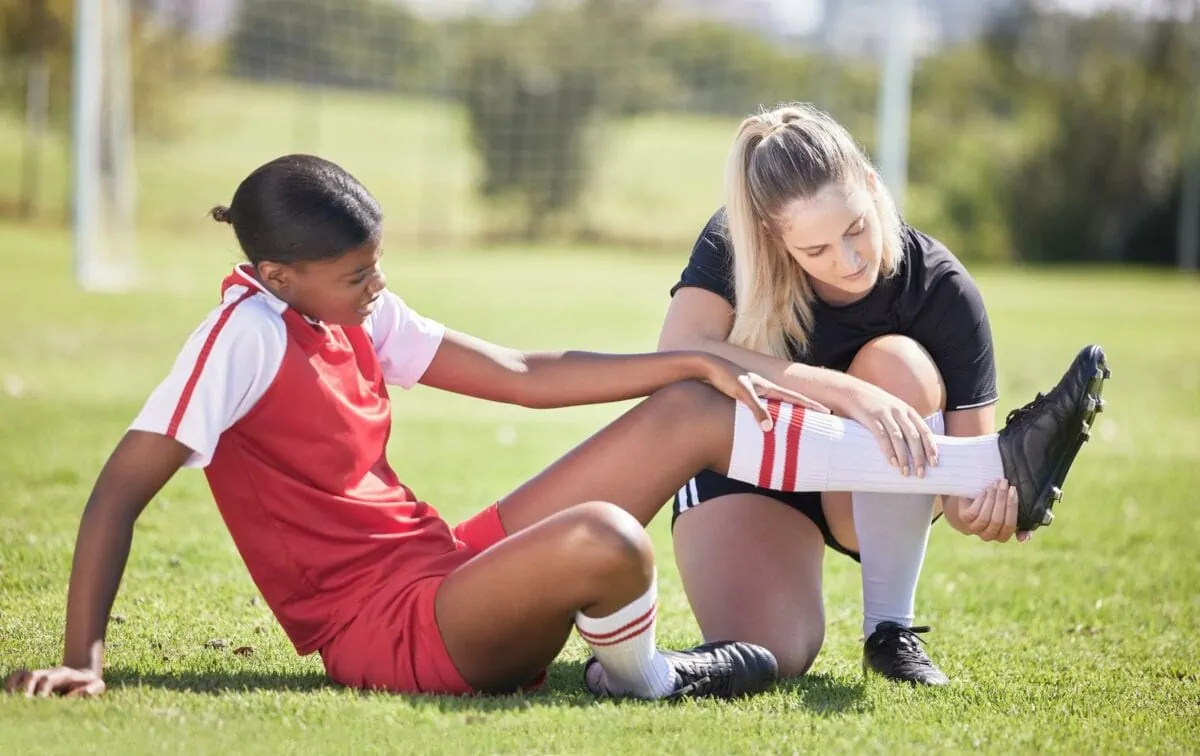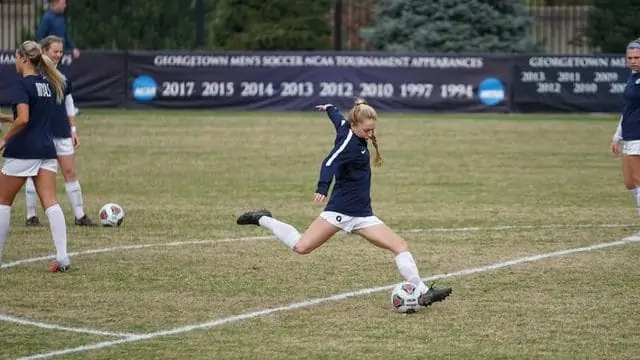Share the post "Protect a Blister While Playing Soccer (How-To Guide)"
Nothing can be more frustrating than playing soccer with painful blisters. Most soccer players develop blisters on the back of their heels or the bottom of their feet at some point.
Not only do they make it difficult to perform during the game, but they can also lead to severe knee or ankle injuries.
Getting blisters from athletic footwear like soccer cleats is a frustrating and painful experience. However, there are some quick and easy methods that you can use to treat and prevent this issue.
Additionally, these blister treatment methods allow you to protect a blister while playing soccer.

What are Blisters?
In simple words, blisters are the fluid accumulation that occurs between skin layers. They appear to be small clear, fluid pockets and soccer players commonly experience them.
How Blisters are Formed
Footwear is one of the most common causes of a blister. New cleats are often too tight, create too much friction with the sock or foot, and start the blister formation process.
Although socks are worn to reduce friction, the type and quality of socks matter a lot.
Friction between material and skin happens because the shoe rubbing makes pressure points or hot spots.
These pressure points turn into blisters if you continue walking or running while wearing shoes, boots, or soccer cleats for a long time.

How to Treat Blisters?
Now that you know how blisters form, let’s discuss the best treatment methods. The following methods will allow you to play soccer comfortably while suffering from blisters.
Clean the Affected Area
First, clean the hot spot thoroughly with water and antiseptic soap. You can also use alcohol for sterilization purposes.
Drain the Blister
After cleaning the affected surface, you’ll need to use a sterile needle or tool to drain the blister. To catch the fluid, consider using a sterile gauze pad.
It’s critical not to remove the dead skin covering even if it’s torn already. The overlying skin works as a protection layer and increases the healing process.
Use Protective Covering on the Blister
The next step is to cover the blister, and you can use gauze, a large band-aid, antibiotic ointment, or second skin to the open wound for immediate relief.
It’s also essential to apply skin lube or Vaseline inside the shoe, sock, and covered area to reduce friction before playing.
Continue Foot Care
You’ll also need to ensure that you keep your foot with the blister dry and continue cleaning the affected area daily. You’ll be able to cut off the dried and dead skin after a few days (make sure not to rip the dead skin).

How to Protect Blisters While Playing Soccer: What to Use?
There are different specialized products available that you can use to protect your blisters while playing soccer. Here’s a list of the best options that you can use.
TRUsox
Many professional soccer players wear TRUsox, which you can use as a second layer to cover your blisters. They reduce friction and tight grip by keeping your skin safe inside the boot and sock.
Pros
- Add extra protection layer with non-slip pads
- Come with a comfortable cushion
- Made with specialized technology that’s great for agility and speed
Cons
- Can be pricey
- TECHNOLOGY: TRUsox patented INEXtech helps you change…
- HOW TO WEAR: Since TRUsox simultaneously grip your foot and…
- THIN VS CUSHIONED: Thin version is worn with newer boots…
- BENEFITS: The added friction maximizes energy transfer in…
- CARE: Machine wash in cold water with like colors. No…
Product: Updated 2024-07-25 | Images: Amazon Product Advertising API | #ad – soccerblade.com is an Amazon Associate
Sof Sole
You can also add Sof Sole to your soccer cleats. It comes in handy if you have a blister on the bottom of your foot. They add a protective layer that keeps your socks in place and reduces slippage and friction.
Pros
- Come with Hydrologix technology that keeps your feet dry and comfortable
- Keeps your socks in place with a deep heel pocket
- Offers full cushion sole
Cons
- Can be too tight
- Offers a thin layer
- ENHANCE YOUR PERFORMANCE: Gel in the heel and forefoot…
- ALL-DAY COMFORT: Foam provides heel-to-toe cushioning that…
- LIGHTWEIGHT SUPPORT: Enjoy enhanced cushioning without added…
- KEEPS FEET FRESH: Moisture controlling Hydrologix technology…
- COOLS YOUR FEET: Midfoot ventilation circulates air within…
Product: Updated 2024-07-25 | Images: Amazon Product Advertising API | #ad – soccerblade.com is an Amazon Associate
Adidas team Speed
Using Adidas Team Speed is another excellent method to keep your blisters protected throughout the play. They’re made of breathable mesh that keeps your feet dry, and you can also use them with other gear.
Pros
- Breathable mesh
- Designed with ankle and arch compression
- 99 percent nylon
Cons
- Can be too tight
- Lightweight construction for a close fit and excellent ball…
- Moisture-wicking yarn keeps feet dry from sweat.
- Mesh channels promote breathability.
- Traxion pods at heel and toe provide cushioning and…
- Targeted arch and ankle compression for secure fit and added…
Product: Updated 2024-07-25 | Images: Amazon Product Advertising API | #ad – soccerblade.com is an Amazon Associate
Second Skin Squares
You can buy different types of second skin squares specially designed for blisters and pain relief. They’re made with water and soothe the affected area by reducing friction and pressure.
All you need to do is to place the squares on your blister after cleaning and apply the band-aid to keep it in place.
Pros
- Add a protective layer with enough cushioning
- Reduce friction and pressure
Cons
- Can come off during play if the band-aid isn’t applied properly.
- All Health
- Medical-grade gel adhesive squares sooth, cool, and protect
- Hypoallergenic, latex free, and non-medicated, these…
- Made mostly from water so the dressings will not stick to…
- Ideal for use in clinics, training rooms, and first aid kits
- 200 gel squares (non-sterile). 1 inch x 1 inch / 2.5cm x…
Product: Updated 2024-07-25 | Images: Amazon Product Advertising API | #ad – soccerblade.com is an Amazon Associate
Gel Blister Cushion
It’s the best option when you feel a blister coming on. You can apply it on a hot spot that’s not yet causing too much discomfort. These gel pads reduce friction, pressure, and slippage and feel comfortable inside boots.
Pros
- Reduce rubbing and friction to heal blisters
- Feel more comfortable than regular band-aids.
Cons
- You need to apply additional pre-wrap to keep these pads in place.
- Advanced blister care: One pack includes 10 hydrocolloid…
- Instant pain relief: Provides 10X more pain relief than…
- Faster healing: Heals 20 percent faster than ordinary…
- Long lasting protection: Stays in place 50 percent longer…
- Discover the Compeed Advantage: Try Compeed, which has one…
Product: Updated 2024-07-24 | Images: Amazon Product Advertising API | #ad – soccerblade.com is an Amazon Associate
How to Prevent Blisters?
Preventing the common causes is the best method to avoid blisters. Here are some ways that you can use it.
Keep Skin Clean and Dry
One of the best ways to avoid blisters is to keep your feet dry. It’s critical to make sure that you dry your feet off before wearing soccer cleats. You can also keep an extra pair of socks.
It comes in handy if your first pair gets wet. Wet feet cause friction and increase the risk of infection dramatically.
Wear Protective Equipment
First of all, you need to make sure that you wear the right size soccer cleats. Too small shoes rub your skin and increase the chances of causing blisters. You can also use protective equipment such as blister prevention tape.
Products such as KT Blister Tape are specially designed to prevent blisters. It can easily stay on your skin for a complete day. This hypoallergenic tape is free of rubber and latex, which means it’s one of the safest and most suitable options for preventing blisters.
- Keep your feet healthy: Designed to help prevent blisters,…
- Ultra-durable: 100% engineered synthetic fiber tape is…
- Stays in place: Blister Prevention Tape leverages KT’s…
- Reduces friction: Designed ultra-light and thin to easily…
- Good to your skin: Does not contain common materials that…
Product: Updated 2024-07-25 | Images: Amazon Product Advertising API | #ad – soccerblade.com is an Amazon Associate
Wear High-Quality Socks
It’s obvious but often overlooked by many soccer players. Low-quality socks can contain harmful material and can also be too thin and increase the chance of blisters.
On the other hand, high-quality socks, specifically designed for soccer players, can absorb as much sweat as possible and keep your feet comfortable.
Get Used to Your New Soccer Cleats
It’s never a good idea to use a new pair of cleats for the first time just before the game. New boots are almost always too uncomfortable and stiff to start playing immediately.
That’s why taking your time and getting used to your new cleats is essential. You can use them for jogging and practicing soccer to prevent blisters.
Use Tape or Padding to Avoid Shoe Rubbing
Some people apply protective tape or padding to certain areas of their feet. It allows the shoe to rub against the protective layer instead of the skin. It’s a great way to avoid blisters that don’t take too much time and effort.
Monitor Field Temperature
The temperature of artificial turf can easily cross 100 degrees Fahrenheit, and that heat can be the reason for blisters. Monitoring the temperature allows you to use the right equipment.
For example, if the temperature is high, you can use a head-shielding insole that ensures comfort and allows you to perform better without worrying about blisters.
Share the post "Protect a Blister While Playing Soccer (How-To Guide)"
Joel is a seasoned soccer journalist and analyst with many years of experience in the field. Joel specializes in game analysis, player profiles, transfer news, and has a keen eye for the tactical nuances of the game. He played at various levels in the game and coached teams - he is happy to share his insight with you.














